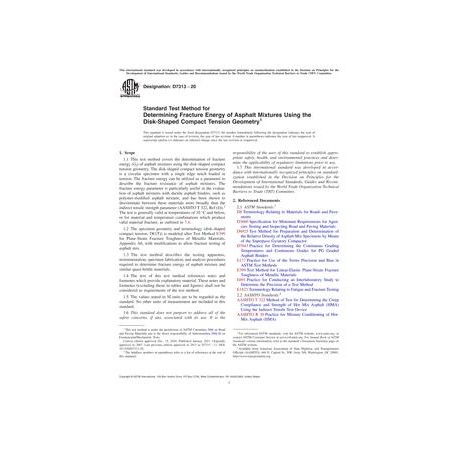No products
 View larger
View larger ASTM D7313-20
M00000535
New product
ASTM D7313-20 Standard Test Method for Determining Fracture Energy of Asphalt Mixtures Using the Disk-Shaped Compact Tension Geometry
standard by ASTM International, 12/15/2020
In stock
More info
Full Description
1.1''This test method covers the determination of fracture energy (Gf) of asphalt mixtures using the disk-shaped compact tension geometry. The disk-shaped compact tension geometry is a circular specimen with a single edge notch loaded in tension. The fracture energy can be utilized as a parameter to describe the fracture resistance of asphalt mixtures. The fracture energy parameter is particularly useful in the evaluation of asphalt mixtures with ductile asphalt binders, such as polymer-modified asphalt mixture, and has been shown to discriminate between these materials more broadly than the indirect tensile strength parameter (AASHTO T 322, Ref (1)).2 The test is generally valid at temperatures of 10'''''C and below, or for material and temperature combinations which produce valid material fracture, as outlined in 7.4.
1.2''The specimen geometry and terminology (disk-shaped compact tension, DC(T)) is modeled after Test Method E399 for Plane-Strain Fracture Toughness of Metallic Materials, Appendix A6, with modifications to allow fracture testing of asphalt mix.
1.3''The test method describes the testing apparatus, instrumentation, specimen fabrication, and analysis procedures required to determine fracture energy of asphalt mixture and similar quasi-brittle materials.
1.4''The text of this test method references notes and footnotes which provide explanatory material. These notes and footnotes (excluding those in tables and figures) shall not be considered as requirements of the test method.
1.5''The values stated in SI units are to be regarded as the standard. No other units of measurement are included in this standard.
1.6''This standard does not purport to address all of the safety concerns, if any, associated with its use. It is the responsibility of the user of this standard to establish appropriate safety, health, and environmental practices and determine the applicability of regulatory limitations prior to use.
1.7''This international standard was developed in accordance with internationally recognized principles on standardization established in the Decision on Principles for the Development of International Standards, Guides and Recommendations issued by the World Trade Organization Technical Barriers to Trade (TBT) Committee.

